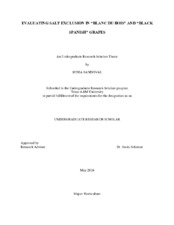| dc.description.abstract | High concentrations of salts in the soil and irrigation water can be damaging to grapevines, and the use of salt tolerant rootstocks is often recommended to grape growers to mitigate the negative impacts of salinity. A greenhouse study was conducted to compare the salt excluding properties of two grapevine cultivars that are commonly grown without the use of a rootstock, Vitis spp. cv Black Spanish and Vitis spp. cv Blanc Du Bois, to fifteen common rootstock cultivars and six fruiting cultivars. Herbaceous cuttings were rooted under an intermittent mist system and subsequently transferred to a fritted clay media. After four weeks of growth, a 25mM sodium chloride solution was applied every other day for an additional two weeks. The vines were then destructively harvested and sodium and chloride concentrations were measured separately in the roots and the shoots to determine the capacity of the root system to exclude and retain salts. Because the herbaceous cuttings were collected in late fall, rooting success and propagule survivability was limited. It is recommended that the study be repeated during a more favorable portion of the growing season to gather more information regarding the salt exclusion properties of Black Spanish and Blanc Du Bois grapes. | en |


